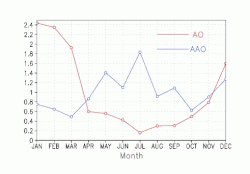Mars cyclone
[left]: Here is the discovery image of the Martian polar storm as seen in blue light (410 nm). The storm is located near 65 deg. N latitude and 85 deg. W longitude, and is more than 1000 miles (1600 km) across. The residual north polar water ice cap is at the top of the image. A belt of clouds like that seen in previous telescopic observations during this Martian season can also be seen in the planet's equatorial regions and northern mid-latitudes, as well as in the southern polar regions. The volcano Ascraeus Mons can be seen as a dark spot poking above the cloud deck near the western (morning) limb. This extinct volcano towers nearly 16 miles (25 km) above the surrounding plains and is about 250 miles (400 km) across.
[upper right]: This is a color polar view of the north polar region, showing the location of the storm relative to the classical bright and dark features in this area. The color composite data (410, 502, and 673 nm) indicate that the storm is fairly dust-free and therefore likely composed mostly of water ice clouds. The bright surface region beneath the eye of the storm can be seen clearly. This map covers the region north of 45 degrees latitude and is oriented with 0 degrees longitude at the bottom.
[lower right]: This is an enhanced orthographic view of the storm centered on 65 deg. N latitude, 85 deg. W longitude. The image has been processed to bring out additional detail in the storm's spiral cloud structures.
The pictures were taken on April 27, 1999 with the NASA Hubble Space Telescope's Wide Field and Planetary Camera 2Relevante Bilder
Relevante Artikel
PolarwirbelEin Polarwirbel (englisch polar vortex) ist eine kohärente Struktur mit absoluter potenzieller Vortizität, die größer ist als die polare planetare potenzielle Vortizität, und die über oder in der Nähe des Pols zentriert ist. Hierbei lassen sich zwei Arten unterscheiden. Einerseits sind Polarwirbel Strömungen, in denen eine überwiegend zirkumpolare zyklonische Strömung vorliegt. Beispiele hierfür sind die polaren Winterzirkulationen der Stratosphäre von Erde und Titan sowie der unteren Atmosphäre des Mars. Andererseits sind Polarwirbel Strömungen kleineren horizontalen Maßstabs, bei denen die zonalen Asymmetrien groß genug sind, dass eine starke zirkumpolare Strömung fehlt oder von untergeordneter Bedeutung ist. Beispiele hierfür sind die Wirbelhaufen des Jupiter oder troposphärische Polarzyklone im synoptischen Maßstab auf der Erde. .. weiterlesen
Planum BoreumAls Planum Boreum wird das Gebiet um den Nordpol des Mars bezeichnet, welches von Vastitas Borealis umgürtet wird. Das Gegenstück am Südpol ist Planum Australe. .. weiterlesen















